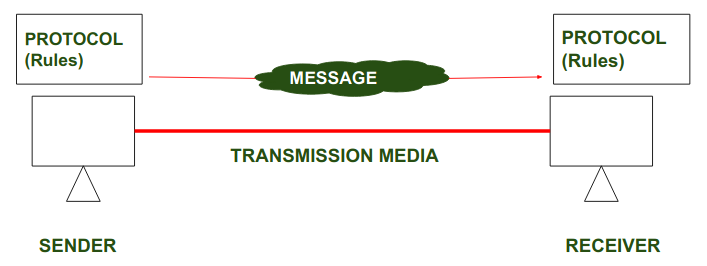1.2 Protocols, Standards, Standard organizations, Bandwidth, Data Transmission rate and Bits per Second
PROTOCOL
- A Protocol is defined as a set of rules that governs data communications.
- A protocol defines what is to be communicated , how it is to be communicated and when it is to be communicated.
- For successful communication to occur, the sender and receiver must agree upon certain rules called protocol.
ELEMENTS OF PROTOCOL
A. SyntaxIt means the structure or format of the data. It is the arrangement of data in a particular order.
B. Semantics
It tells the meaning of each section of bits and indicates the interpretation of each section.
It also tells what action/decision is to be taken based on the interpretation
C. Timing
It tells the sender about the readiness of the receiver to receive the data.
STANDARDS:
Standards are the set of rules for data communication that are needed for exchange of information among devices. It is important to follow Standards which are created by various Standard Organization like IEEE , ISO , ANSI etc.
Types of Standards :
Standards are of two types :
- De Facto Standard.
- De Jure Standard.
De Facto Standard : The meaning of the work ” De Facto ” is ” By Fact ” or “By Convention”.
These are the standard s that have not been approved by any Organization , but have been adopted as Standards because of it’s widespread use. Also , sometimes these standards are often established by Manufacturers.
For example : Apple and Google are two companies which established their own rules on their products which are different . Also they use some same standard rules for manufacturing for their products.
De Jure Standard : The meaning of the word “De Jure” is “By Law” or “By Regulations” .
Thus , these are the standards that have been approved by officially recognized body like ANSI , ISO , IEEE etc. These are the standard which are important to follow if it is required or needed.
STANDARD ORGANIZATIONS
Standard Organizations for Data Communication :
1) International Standard Organization (ISO) –
ISO is the International Organization for Standardization. It creates set of rules and standards for graphics , document exchange , data communication etc.
2) Consultative Committee for International Telephony and Telegraphy (CCITT) –
CCITT is now standard organization for the United States. CCITT developer’s recommended set of rules and standards for telephone and telegraph communication.
It has developed 3 set of specifications :
- V Series for Modern Interfacing.
- X series for Data Communication.
- Q series for Integrated Services Digital Network(ISDN).
3) American National Standard Institute (ANSI) –
ANSI is primary organization for fostering the development of technology standards in the United States and providing various set of rules and standard for Data Communication.
4) Institute of Electrical and Electronic Engineering (IEEE) –
It is US based professional organization of electronic , computer and communication engineering. It provides various set of rules and standard in communication and networking field.
5) Electronic Industries Association(EIA) –
This organization establish and recommends industrial standards. EIA has developed the RS(Recommended Standards) series of Standards for data and telecommunication.
6) Standard Council of Canada (SCC) –
It is an official Standard Agency for Canada . It has Similar responsibilities as ANSI has.

Comments
Post a Comment